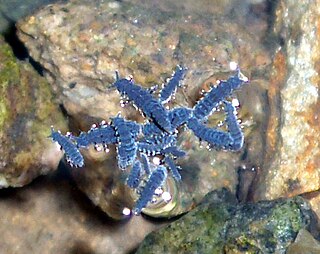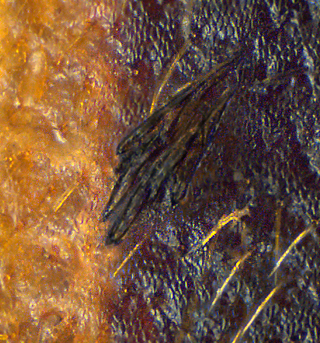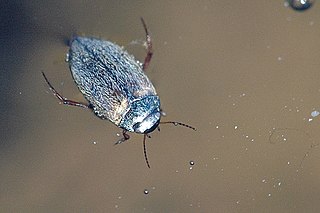Pierre Nicolas Camille Jacquelin Du Val was a French entomologist who specialised in Coleoptera.

Joseph Alexandre Laboulbène was a French physician and entomologist. A friend of the entomologist Jean-Marie Léon Dufour (1780-1865), he studied medicine in the University of Paris and was awarded the title Docteur in 1854. He taught in the medical faculty until 1879. Laboulbène was interested in harmful insects notably in the Order Diptera. The order of mushrooms Laboulbeniales, is dedicated to him, by Engler in 1898.

Anurida maritima, the seashore springtail, is a cosmopolitan collembolan of the intertidal zone. It is often found in aggregations of up to several hundred on the surface of rock-pools.
Laboulbène is a commune in the Tarn department in southern France.

The family Neanuridae contains pudgy short-legged springtails of the order Poduromorpha. It was established by Carl Börner in 1901.

Laboulbenia is a genus of fungi in the family Laboulbeniaceae.

Hydroporus is a genus of water beetles native to the Palearctic, the Nearctic, the Near East, and North Africa. It contains the following species:
Pseudomasoreus is a genus in the beetle family Carabidae. There are more than 20 described species in Pseudomasoreus.
Aepopsis is a genus in the beetle family Carabidae. This genus has a single species, Aepopsis robinii.
Harpalus cephalotes is a species of ground beetle in the subfamily Harpalinae. It was described by Fairmaire & Laboulbene in 1854. It thrives in both high-temperature areas and highly saline soils. It is the only member of the cephalotes subgenus. It has two subspecies: H. c. cephalotes, found across south-central Europe east to Kazakhstan and the Turkey/Transcaucasus region; and H. c. somcheticus, found in dry parts of eastern Anatolia, Armenia, and Israel.

In biology, being semi-aquatic refers to various macroorganisms that live regularly in both aquatic and terrestrial environments. When referring to animals, the term describes those that actively spend part of their daily time in water, or land animals that have spent at least one life stages in aquatic environments. When referring to plants, the term describes land plants whose roots have adapted well to tolerate regular, prolonged submersion in water, as well as emergent and (occasionally) floating-leaved aquatic plants that are only partially immersed in water.

Plutomurus ortobalaganensis is the deepest terrestrial animal ever found on Earth, living at 1,980 metres (6,500 ft) below a cave entrance. It is a species of springtail (arthropods) endemic to the Krubera-Voronja cave system in Abkhazia, Georgia. It was discovered in the CAVEX Team expedition of 2010. It feeds on a few fungi and decomposing organic matter in the caves.

Anurida stereoodorata is a species of springtails (arthropod) endemic to the Krubera-Voronja cave system in Georgia. It is one of the deepest terrestrial animals ever found on Earth, living at >1,800 metres (5,900 ft) below the cave entrance. It was discovered in the CAVEX Team expedition of 2010.

Deuteraphorura kruberaensis is a species of springtails belonging to the family Onychiuridae. It is endemic to the Krubera-Voronja cave system in Georgia. It is one of the deepest terrestrial animal ever found on Earth, living at >1,800 metres (5,900 ft) below the cave entrance. It was discovered in the CAVEX Team expedition of 2010.
Schaefferia profundissima is a species of springtail (arthropods) endemic to the Krubera-Voronja cave system in Georgia. It is one of the deepest terrestrial animal ever found on Earth, living at >1,800 metres (5,900 ft) below the cave entrance. It was discovered in the CAVEX Team expedition of 2010.

Pseudachorutinae is a subfamily of springtails in the family Neanuridae. There are more than 50 genera and 200 described species in Pseudachorutinae.

Mycetoporus is a genus of crab-like rove beetles in the family Staphylinidae. There are at least 70 described species in Mycetoporus.
Euthiconus is a genus of beetles belonging to the family Staphylinidae.
Foveacheles is a genus of mites belonging to the family Rhagidiidae.









